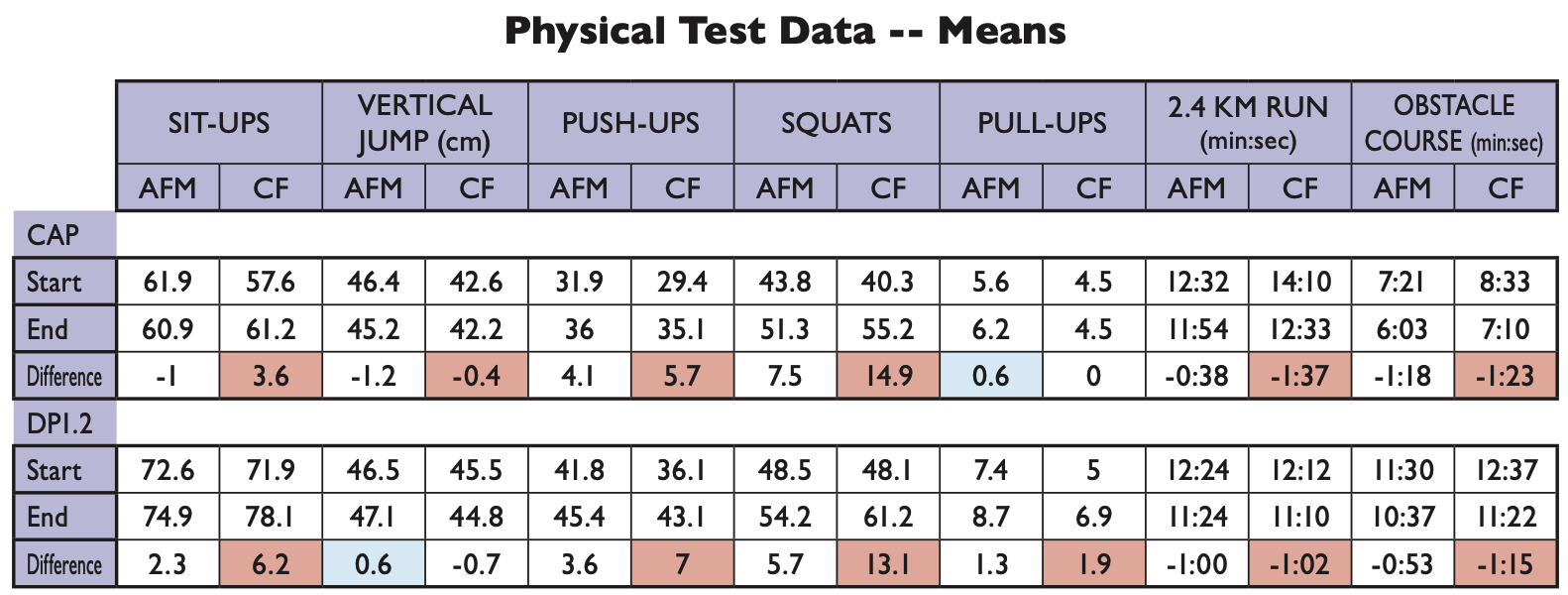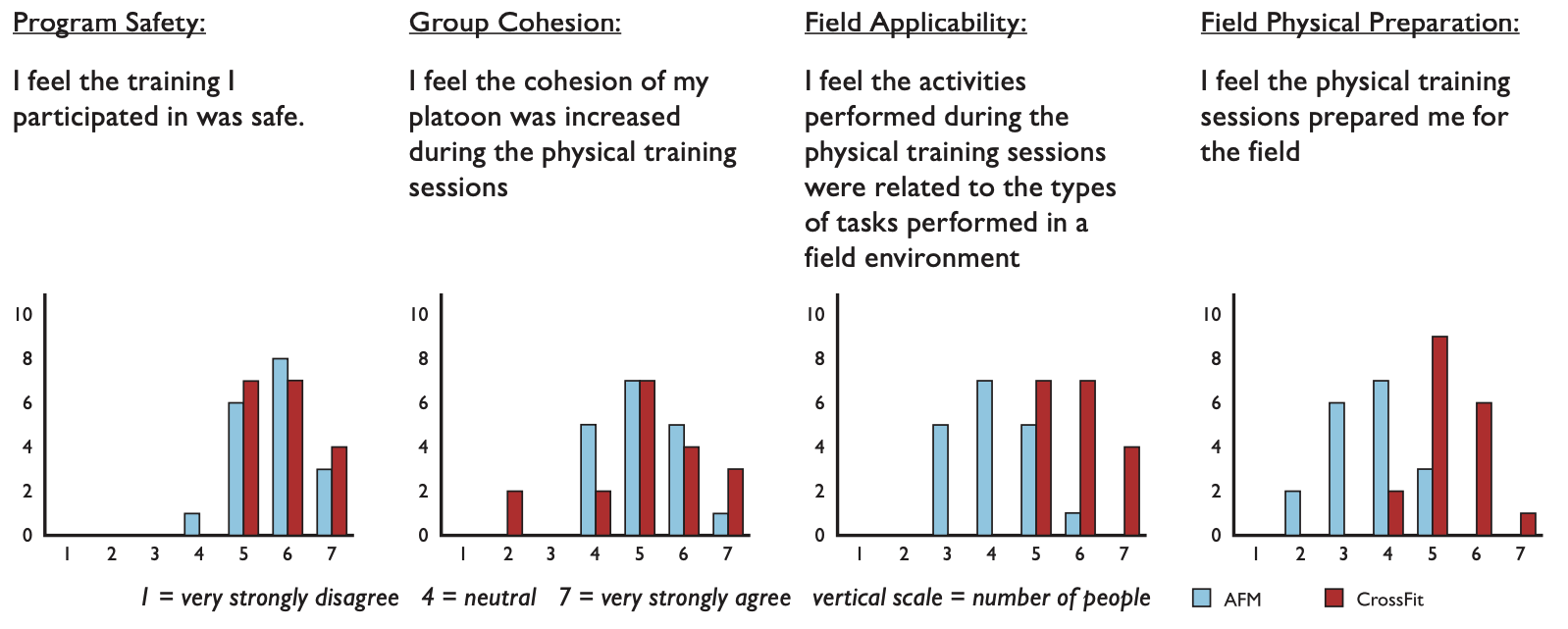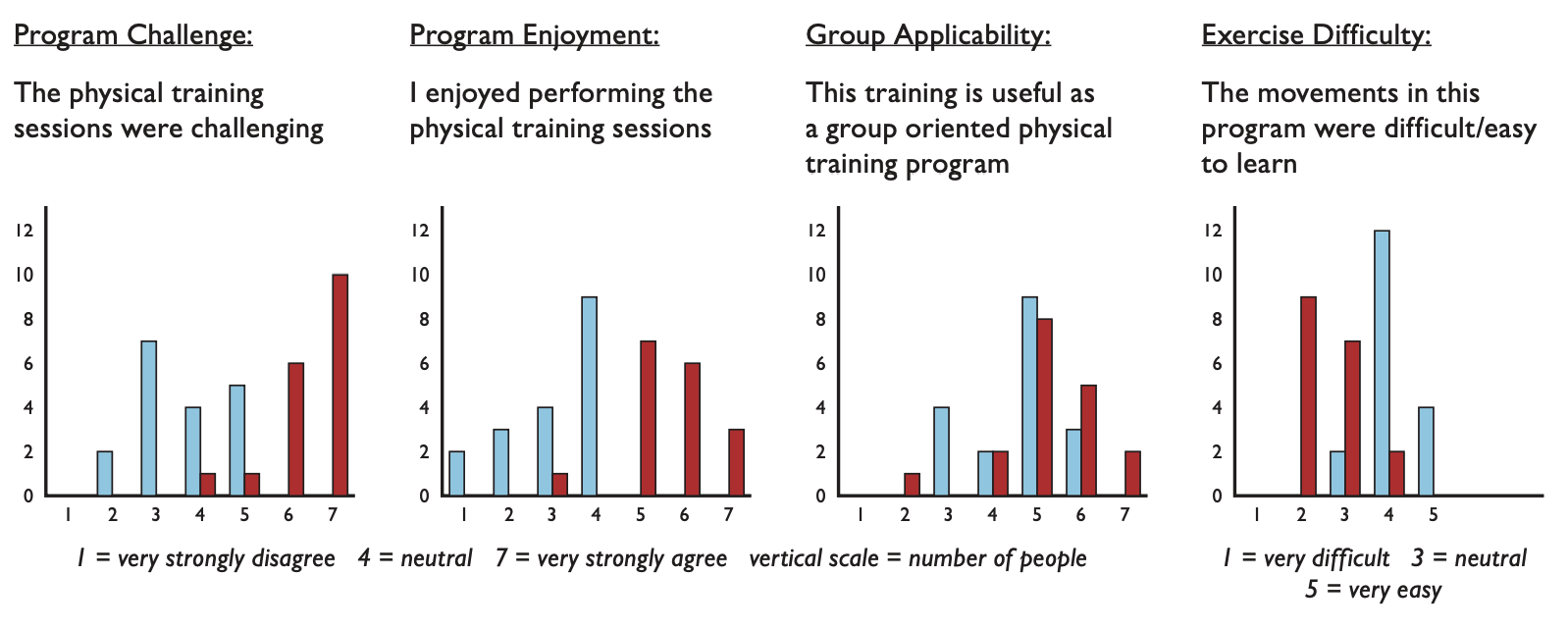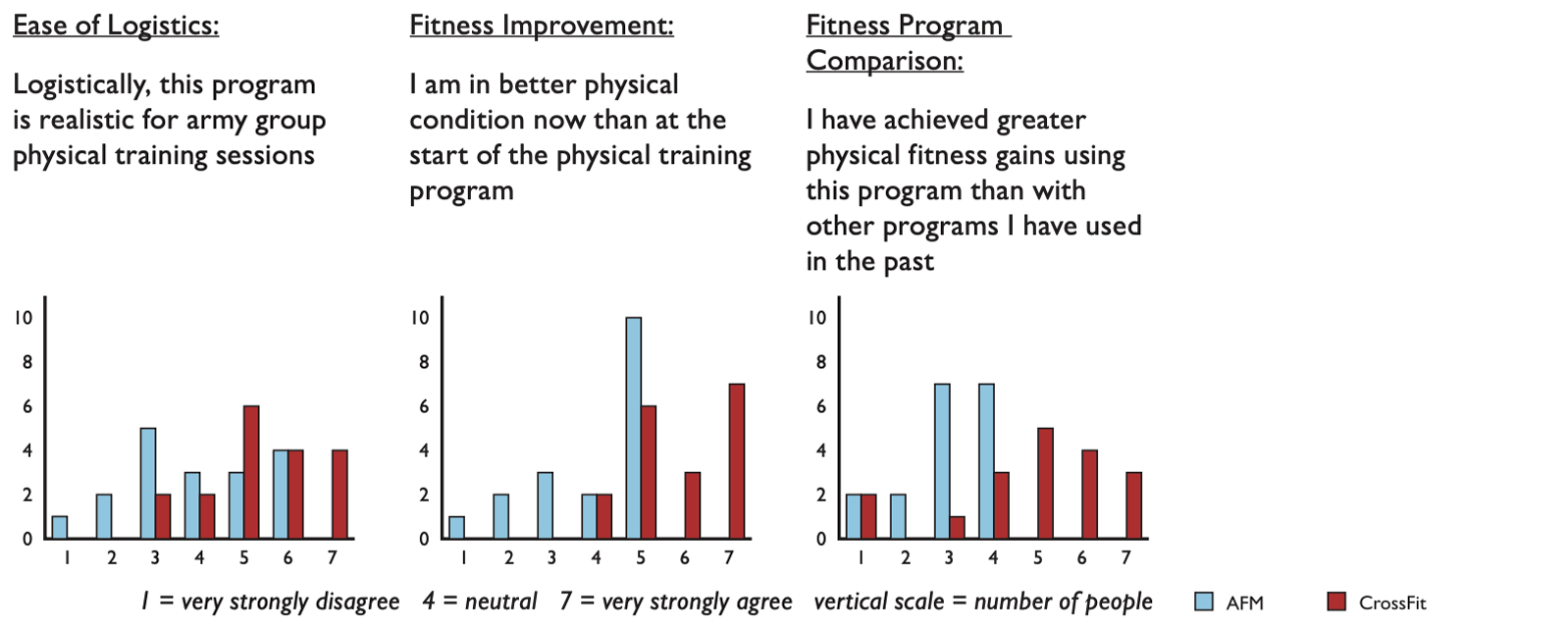Last year the Royal Canadian Infantry School, CFB Gagetown, New Brunswick, Canada, tested the validity of the CrossFit concept against the extant Canadian Army fitness program (AFM).
U.S. and Coalition Forces personnel can contact Coach Greg Glassman (greg@crossfit.com) for more information about the trial or CrossFit implementation, or to contact the Canadian Infantry School CrossFit Cell.
We want to thank the officers of the Canadian Infantry School and Instructors from PSP (Personnel Support Programs) for their incredible professionalism, warm hospitality, and commitment to state-of-the-art military physical training.
The summary and tables that follow were excerpted from the final report of the trial.
Royal Canadian Infantry School Army Fitness Manual/ CrossFit Trial Results
- In March 2005 the Canadian Infantry School was authorized to conduct a physical fitness trial that would test the validity of the CrossFit concept using the AFM as the baseline model.
- CrossFit develops the same aspects of fitness as the AFM – aerobic conditioning, muscular strength/ endurance, flexibility, and power.
- Utilized a different modus operandi than traditional military fitness program.
Testing Protocols
The effectiveness of the two programs was gauged using the following measures:
- Physical testing – PT test and obstacle course
- Student perceptions of the program
- Injury rate during the trial
- Testing was conducted at the beginning and end of PT phase
- One group, DP 1.2, final crse for infantry officer prior to posting to a regiment and assuming command of Platoon, seven weeks of training
- Other group, CAP, 1st Army course for land component officers, eight weeks of training
- Quantifiable success measure was the improvement score between the first and second test.
- Student perceptions were gauged by questionnaire
- Injuries were recorded through CF medical system and course records
PT Test Events
- Sit-ups – max in two minutes
- Vertical Jump – two minutes for two attempts
- Push-ups – max in two minutes
- Deadlift – max reps in two minutes, 2 X 40 lbs dumbbells
- Pull-ups – max reps in one minute
- 2.4 km run – outdoor course
Obstacle Course Test
- Individual performance for fastest time
- Three attempts per obstacle without one minute penalty
- Dress CADPAT, Kevlar, and gloves
- CAP: 19 obstacles
- DP1.2: 23 obstacles
- Designed to gauge the physical capacities of the students across a wide range of general physical skills.
- Developed by PSP and Inf School
- Used AFM “fitness checks”
- Each test stand supervised by PSP
- Staff evaluated only one test stand to ensure standardization
- Students identified by numbers only
Student Perceptions
- DP 1.2 crse provided input
- Questionnaire conducted after completion of all physical testing
- Purpose was to provide the candidates with an anonymous forum to obtain their feedback, without influence, on the PT program they were utilizing
- General rating scale and open-ended questions were used
Questions
- Program Safety
- Group Cohesion
- Field Applicability
- Field Physical Preparation
- Program Challenge
- Program Enjoyment
- Exercise Difficulty
- Group Applicability
- Ease of Logistics
- Fitness Improvements
- Fitness Program Comparison
Injury Rate
- Important measure of program utility
- Data obtained for Return to Unit (RTU) students
- Must have completed initial PT test
- Injury during PT, or a physical activity in garrison or in the field
- Chronic injuries were assessed as “non-attributable and attributable”
- Any injury not attributed to physical training was not recorded, ie ear injury
AFM Program
- Conducted IAW the “12 week Army Fitness Program”
- Workouts included warm up, exercise (40-50 min), and cool down
- Supervised by course instructor
Workouts consisted of:
- Aerobic intervals
- Continuous aerobic training
- Strength and power training
- Optional day (weight-load marching, sports, or make up day)
CrossFit Program
- Based on CrossFit Journal and CrossFit site
- Workouts included warm up, exercises (15-25 min), and cool down
- Remainder of workout either used for skill instruction, external object movement, or body control
- Supervised by course instructor
Workouts consisted of:
- Skill training (weightlifting or body control)
- Single-skill training (MAT, O-lifting, weight load marching)
- Multiple skill training (run, weight, body control)
Summary of Statistical Analysis
- Data suggests that CrossFit induced greater leg and core strength
- CrossFit induced equal or greater cardiovascular improvements while performing less than half the running
- In no exercise did the CrossFit groups show less significant improvement than the AFM groups
Explanation of Results
- Results suggest CrossFit groups either matched or out performed the AFM groups
Injury Results and Analysis
- AFM 6 Attributable injuries
- CrossFit 2 Attributable injuries
Possible Bias
- Requirement to have CrossFit certified instructor conduct training as well as serving as Trial Officer
To mitigate the possible bias:
- PT testing was jointly developed by CFB Gagetown PSP Staff
- PT testing was supervised by PSP staff
- Events for the PT test were the AFM fitness checks (bias in favor of the AFM)
- Obstacle course was not an advantage to either group
- Neither group was tested on a CrossFit workout
- Data was collected, entered, processed by a third party
Conclusion
- The CrossFit group made equal or greater strength gains than the AFM with shorter workouts
- The CrossFit group obtained equal the aerobic gains while performing less than half the running
- The increased education level of the CrossFit instructors assisted in the performance of the CrossFit group
This article, by BSI’s co-founder, was originally published in The CrossFit Journal. While Greg Glassman no longer owns CrossFit Inc., his writings and ideas revolutionized the world of fitness, and are reproduced here.
Coach Glassman named his training methodology ‘CrossFit,’ which became a trademarked term owned by CrossFit Inc. In order to preserve his writings in their original form, references to ‘CrossFit’ remain in this article.
Greg Glassman founded CrossFit, a fitness revolution. Under Glassman’s leadership there were around 4 million CrossFitters, 300,000 CrossFit coaches and 15,000 physical locations, known as affiliates, where his prescribed methodology: constantly varied functional movements executed at high intensity, were practiced daily. CrossFit became known as the solution to the world’s greatest problem, chronic illness.
In 2002, he became the first person in exercise physiology to apply a scientific definition to the word fitness. As the son of an aerospace engineer, Glassman learned the principles of science at a young age. Through observations, experimentation, testing, and retesting, Glassman created a program that brought unprecedented results to his clients. He shared his methodology with the world through The CrossFit Journal and in-person seminars. Harvard Business School proclaimed that CrossFit was the world’s fastest growing business.
The business, which challenged conventional business models and financially upset the health and wellness industry, brought plenty of negative attention to Glassman and CrossFit. The company’s low carbohydrate nutrition prescription threatened the sugar industry and led to a series of lawsuits after a peer-reviewed journal falsified data claiming Glassman’s methodology caused injuries. A federal judge called it the biggest case of scientific misconduct and fraud she’d seen in all her years on the bench. After this experience Glassman developed a deep interest in the corruption of modern science for private interests. He launched CrossFit Health which mobilized 20,000 doctors who knew from their experiences with CrossFit that Glassman’s methodology prevented and cured chronic diseases. Glassman networked the doctors, exposed them to researchers in a variety of fields and encouraged them to work together and further support efforts to expose the problems in medicine and work together on preventative measures.
In 2020, Greg sold CrossFit and focused his attention on the broader issues in modern science. He’d learned from his experience in fitness that areas of study without definitions, without ways of measuring and replicating results are ripe for corruption and manipulation.
The Broken Science Initiative, aims to expose and equip anyone interested with the tools to protect themself from the ills of modern medicine and broken science at-large.
Support the Broken Science Initiative.
Subscribe today →
recent posts
Medical Society Webinar with David Wiss








